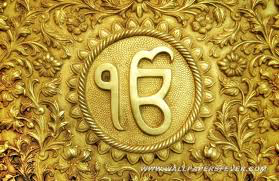
“Ek Onkar,” the Sikh symbol of divine unity
The Sikh religion is the most recent major world religion. It is the fifth largest religion with approximately 25 million followers globally today. The founder of the Sikh religion, Guru Nanak, was born into a relatively affluent family in the Punjab in 1469. He composed beautiful poetry in Punjabi that forms the heart of the Sikh scriptures. His verses combine poetry, spiritual striving and the values of hard work and social engagement. He also introduced religious reforms that were radical for his time in South Asia and in the world at large. He abhorred caste hierarchies and preached the equality of all people, regardless of caste, class, and gender. He was one of the first major historical figures to espouse the equality of women. Although Sikhism is often misunderstood as a blending of Hinduism and Islam, Guru Nanak created a new religion with distinctive values and beliefs. The first followers of Guru Nanak were called “Sikhs” (learners or disciples).
BRIEF OVERVIEW OF SIKH VALUES AND BELIEFS
Belief in One God
The Importance of the Guru
The concept of the Guru lies at the heart of the Sikh faith. For Sikhs, the Guru is the divine light that dispels darkness. Guru Nanak, the founder of Sikhism, is regarded as the embodiment of the divine light. The concept of the Guru also encompasses the idea of union with the divine. The Guru (or divine teacher) guides the Sikhs (learners, disciples, or seekers of Truth) towards spiritual union with God.
Sri Guru Granth Sahib (Sikh Scriptures)
There were ten Gurus in the history of the Sikh faith beginning with Guru Nanak and ending with Guru Gobind Singh. Guru Gobind Singh completed the succession of living gurus and conferred the divine light into the Sri Guru Granth Sahib (Sikh scriptures) which is considered the Eternal Living Guru and spiritual leader in Sikhism. The Living Guru is a divine revelation of the truth meant to benefit all of humanity.
Devotional Music
The singing of hymns (shabad) from the Sri Guru Granth Sahib is a core feature of Sikh devotional practice. Often the devotional singing is accompanied by live musical accompaniment. Listen to the recitation of the “Ek Onkar” hymn. In the first hymn ever composed by Guru Nanak in which he expresses the belief in a Universal God that is formless and all-pervading.
“Ek Onkar“
There is One God.
Truth is his name. He is the creator.
He is without fear. He is without hate.
He is timeless and without form.
He is beyond birth and death. The enlightened one.
He can be known as the Guru’s Grace.
Meditate on the name.
He was true before the creation.
He was true when ages commenced.
He is true now.
He will always be true.
The Three Golden Rules
The three daily life principles for the Sikhs are:
- To remember God at all times
- To work hard and serve the broader community, acting in a selfless and truthful manner, and
- To share the fruit of one’s labor to benefit the entire community.
Communal Kitchen (Langar Hall)
An essential feature of every Gurdwara is the langar hall, which is both a communal kitchen and collective meal that is served by volunteers to anyone who enters the temple. Sikhs take special pride in the langar hall as it embodies two core Sikh values – equality and community service (seva). Everyone eats together, sitting on the floor. The communal kitchen is a rejection of the caste system in India and reflects the belief that an essential activity in an enlightened society is to share a common meal together.
The Khalsa and the Five Symbols of the Sikh Faith
The tenth Guru, Guru Govind Singh, created the khalsa (meaning pure or free) brotherhood and sisterhood in 1699 that are devoted to truthfulness of thought and action. All members of the khalsa are supposed to be equal. Sikh men who are initiated in the khalsa are named Singh (lion) and women are named Kaur (princess). These names denote belonging to the faith, as well as the equality of all community members.
Sikhs who are initiated into the Sikh brotherhood wear the five symbols called the “Five Ks:”
- Kesh – uncut hair and beard
- Kangha – a wooden comb as a symbol of cleanliness
- Katchera – special shorts as a reminder of the commitment to purity
- Kara – a steel circle worn on the right wrist as a commitment to truth
- Kirpan – a small sword to show dedication to defending righteousness and the weak.
In addition, the turban is a religious and cultural symbol signifying one’s commitment to Sikh values and way of life, as well as a sense of pride and belonging to the Sikh community.
Sources:
Nesbitt, Eleanor. Sikhism: A Very Short Introduction (Oxford: Oxford University, 2005).
For audio recordings and translations of Sikh hymns, visit: http://www.sikhizm.com/
